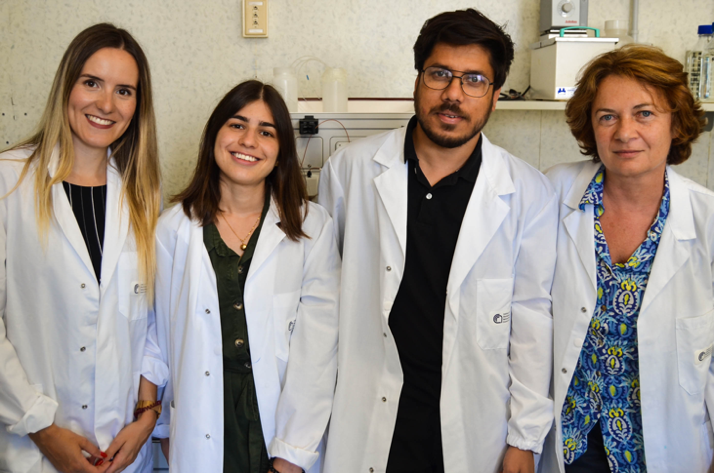Group Leader : Francesca Maria Pisani
Topics: Biochemistry
The goal of our research is to dissect structural/functional relationships of enzymes and proteins involved in DNA replication and genome stability maintenance. In the past our activity was focused on the biochemical characterization of DNA replication factors from Archaea. The archaeal DNA replication machinery, being a simplified version of the eukaryal one, represents a useful model for understanding the molecular bases of this process in Eukarya. This notion has been proven to be true especially in the case of the mini-chromosome maintenance (MCM) complex, which plays the role of the replicative DNA helicase at the archaeal/eukaryal replication fork. Most archaeal species possess a single MCM homolog that forms ring-like homo-hexameric (or double-hexameric) complexes, whereas in the eukaryotic cells the MCM complex is formed by six paralogous proteins that are associated in hetero-hexameric assemblies (MCM 2-7). Biochemical and structural studies carried out in our laboratory on the MCM complex of the hyper-thermophilic archaeon Sulfolobus solfataricus allowed us to: i) identify amino acid residues critical for DNA binding/remodelling; ii) dissect the protein modular organisation; iii) solve the three-dimensional structure of the N-terminal domain (residues 1-268) by X-ray crystallography.
We are now studying many human DNA replication/repair factors with the aim of getting more insight into their action mechanism (GINS, Cdc45, Mcm2-7, Mcm10, the replicative DNA polymerases). In particular, in the recent years we undertook the study of the molecular and cellular functions of DDX11 and FANCJ, two iron-sulphur (Fe-S) cluster-containing super-family 2 DNA helicases, whose mutations are linked to the genome instability disorders Warsaw breakage syndrome and Fanconi anaemia, respectively. DDX11 and FANCJ are both associated to the ongoing replisomes and cooperate with the fork protection complex (FPC, formed by the replication factors Timeless, Tipin, Claspin and AND-1) in assisting smooth progression of the replication forks at difficult-to-replicate templates. These latter are genomic sites prone to give rise to stable secondary structures (such as G-quadruplexes, triplexes and hairpins) that represent sort of roadblocks to the replication machinery progression. In fact, the replicative DNA helicase (the MCM 2-7 complex) is unable to dismantle these alternative structures that cause replication fork stalling. On the other hand, DDX11 and FANCJ were found to be able to resolve the above unconventional nucleic acid structures in vitro with different substrate specificity and are believed to play a key role in allowing the ongoing replisomes to overcome these obstacles. Our present research aims to unveil the molecular mechanisms underlying the interplay of DDX11 and FANCJ with the FPC in promoting duplication of these difficult-to-replicate genomic regions to counteract the consequent replication stress.
Key Pubblications
- Pucci B, De Felice M, Rossi M, Onesti S, Pisani FM. Amino acids of the Sulfolobus solfataricus mini-chromosome maintenance-like DNA helicase involved in DNA binding/remodeling. J Biol Chem. 2004 Nov 19;279(47):49222-49228. Epub 2004 Sep 14. PMID: 15371413.
- De Falco M, Ferrari E, De Felice M, Rossi M, Hübscher U, Pisani FM. The human GINS complex binds to and specifically stimulates human DNA polymerase alpha-primase. EMBO Rep. 2007 Jan;8(1):99-103. Epub 2006 Dec 15. PMID: 17170760.
- Krastanova I, Sannino V, Amenitsch H, Gileadi O, Pisani FM*, Onesti S*. Structural and functional insights into the DNA replication factor Cdc45 reveal an evolutionary relationship to the DHH family of phosphoesterases. J Biol Chem. 2012 Feb 3;287(6):4121-4128. doi: 10.1074/jbc.M111.285395. Epub 2011 Dec 6. PMID: 22147708. (*Corresponding Authors).
- Calì F, Bharti SK, Perna RD, Brosh RM Jr, Pisani FM. Tim/Timeless, a member of the replication fork protection complex, operates with the Warsaw breakage syndrome DNA helicase DDX11 in the same fork recovery pathway. Nucleic Acids Res. 2016 Jan 29; 44(2):705-17. doi: 10.1093/nar/gkv1112.
- Cortone G, Zheng G, Pensieri P, Chiappetta V, Tatè R, Malacaria E, Pichierri P, Yu H, Pisani FM. Interaction of the Warsaw breakage syndrome DNA helicase DDX11 with the replication fork-protection factor Timeless promotes sister chromatid cohesion. PLoS Genet. 2018;14(10):e1007622. Published 2018 Oct 10. doi:10.1371/journal.pgen.1007622.
Research group

|
PhD student: Ana Boavida (AntiHelix ETN – early-stage researcher, ESR) ana.boavida@ibbc.cnr.it Diana Santos (AntiHelix ETN – early-stage researcher, ESR) diana.santos@ibbc.cnr.it Pre-doctoral fellows: Mohammad Mahtab md.mahtab@ibbc.cnr.it |
Programs & resourcers
- H2020-MSCA European Training Network (ETN) – Innovative Training Network
“DNA helicases in genome maintenance: from molecular and cellular mechanisms to specific inhibitors as potential drugs” (Acronym: AntiHelix).
AntiHelix webpage: https://www.elettra.eu/AntiHelix/
AntiHelix Twitter account: https://twitter.com/anti_helix (@anti_helix) - Centro per la Ricerca di Nuovi Farmaci per Malattie Rare Trascurate e della Povertà (CNCCS) – Warsaw Breakage Syndrome.
CNCCS website: https://www.cnccs.it
